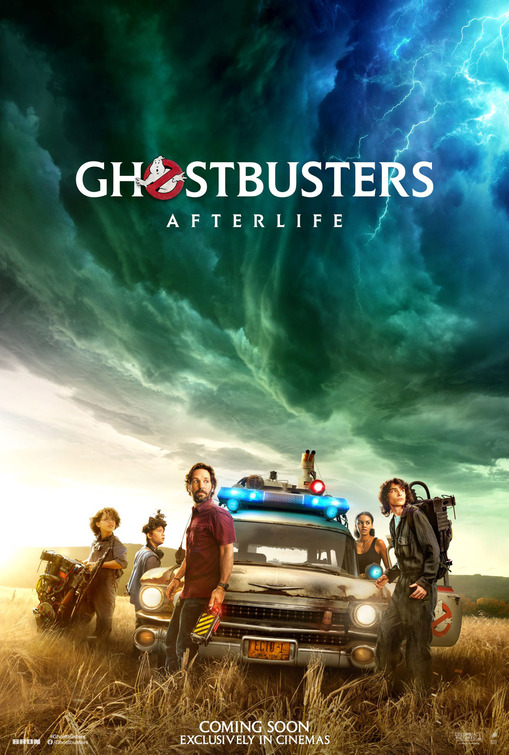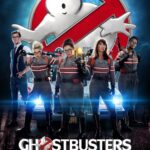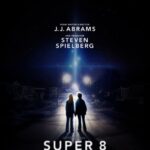Discover The Past. Save The Future.
Director
Jason Reitman
Starring
Mckenna Grace
Logan Kim
Finn Wolfhard
Celeste O’Connor
Carrie Coon
Paul Rudd
Several years after the events of Ghostbusters, Egon Spengler is estranged from his family and living out in a remote Oklahoma town. Desperately fleeing a haunted mountain, Egon attempts to trap an invisible force chasing him but is killed in the process. We are then introduced to Egon’s daughter Callie [Coon] and her two kids Trevor [Wolfhard] and Phoebe [Grace]. Indifferent to her father’s demise, Callie is solely interested in selling whatever property Egon owned to pay her overdue rent. This turns out to be a bit of an ordeal and the group are forced to spend the whole summer in the sleepy town of Summerville. Trevor scores a job at a local diner while Phoebe attends a poor excuse for a summer school but there she meets substitute teacher and seismologist Gary Grooberson [Rudd] and the two start to unravel the mystery of why the town is experiencing tremors and ultimately what Egon was up to.
The way the opening scene is presented, you are immediately drawn in. The pacing, tension and suspense are strong and intriguing but then the movie slams on the brakes and takes a solid hour to get back to that peak. In that time we get some truly magnificent character development but the world-building doesn’t make the most sense. The first question writers need to ask when penning a Ghostbusters sequel shouldn’t be “what are the original four up to?” it should be “what does a world with ghostbusting look like?” And Ghostbusters: Afterlife fails spectacularly. The events of the first two films are downplayed to the point of being entirely forgotten and relegated to a localised hysteria. But then we must remember this is not an Ivan Reitman film, it’s a Jason Reitman film and while the two directors share a name, their oeuvre is entirely different in terms of tone and themes. So much of this movie feels like a hazy recollection of a childhood friend, elements of familiarity are there but they’ve changed yet are entirely fixated on events from the past. An interesting parallel example is the score. Elmer Bernstein’s score for the original Ghostbusters is loud and bombastic and surprisingly jazzy. Rather than carving its own distinct soundscape, Rob Simonsen has opted for a fairly decent initiation but it’s still a pretty glaring imitation and as such, doesn’t feel that memorable.
To switch focus for a moment, we should cover the film’s ultimate weapon.. other than nostalgia. McKenna Grace is the highlight of this movie; more than that, she carries the movie. Funny, quirky and determined, Phoebe is essentially taking the same cue as the score – imitation – but where the soundtrack fails to escape the shadow of its predecessor, Grace surpasses the source material. In other words, she’s a better Egon than Egon; more rounded, interesting and likeable. In fact, when she is paired with her first real friend, a tenacious student named Podcast [Kim], it’s almost like watching a prequel story covering the origin of Egon and Ray’s friendship. But with so much of the script’s time and energy devoted to these two charming kids, everything else is sacrificed. While Phoebe is heavily into science and following her grandfather’s path, Trevor is more like his mother and effectively feels like he’s been plucked from an entirely different film. So much so that his story feels disconnected from everything else. Then we have the two adult characters, Reitman’s classic Gen X/Millennial dysfunctional individuals who are more than capable but are spiralling on the spot. Both Rudd and Coon give commendable performances and inject a decent amount of personality and humour into the proceedings but with the kid / parent / grandparent dynamic from something like National Treasure, there’s an air of immaturity that makes me wonder who the intended demographic for this movie is. Are we talking about 30+ year olds who will relate to the nostalgia and antics or is this for a new generation of kids who see their parental figures as financially irresponsible miseries?
**heavy spoilers covered within**
Every attempt to continue the Ghostbusters franchise has struggled (at least in live-action form) and regrettably, Ghostbusters: Afterlife is no different, treating the original film as sacred and everything therein as perfect history not to be tampered with. To the degree that the only new thing it has to offer is family members and a dusty arid setting. As is abundantly clear from the trailers, the main adversary is Gozer.. again. For those that don’t remember Ghostbusters (and the film will assume you don’t exist), Gozer is the threat from the first film. They are an ancient interdimensional being.. actually, to be honest, I don’t think we’ve ever really understood what Gozer is. It’s clearly a physical threat but they have no agency so I have no idea what their plan is or why they are a danger. The whole Vince Clortho/Keymaster, Zuul/Gatekeeper, devil dog possession stuff.. I know all of this because it’s the story of Ghostbusters but I honestly couldn’t tell you much more because this film has so little to offer. We get the exact same threat with mostly the same resolve, only this time with the added Harry Potter stream vs stream visual. What’s more worrying is that during the opening scene, Egon traps the spirit of the gatekeeper, so one could argue that the only reason the town is in danger is because Phoebe and Gary opened the trap. But moving on, it’s clear the writers wanted to hit the same nostalgia beats but wanted to make their own mark.. sort of. So we have Gozer and the dogs but the iconic visual that has endured for the last thirty seven years is the Stay Puft Marshmallow Man. The problem is, this film doesn’t really flow in the same way. We don’t get the satisfaction of a lot of ghostbusting – in truth, there’s actually remarkably little in the way of hunting, trapping and busting ghosts; I’m quietly convinced they only really do this once throughout the entire film (excluding Gozer, of course). So with a giant rampaging monster off the table, we are instead treated to the Gremlins version, with lots of little Marshmallow Men. And yeah, it’s cute and funny at times and it’ll sell toys but it doesn’t make sense. The only reason this happens is to fulfil an action beat and milk the nostalgia teat.
There’s a lot to love in Ghostbusters: Afterlife: the cinematography and direction are pleasing, the performances have palpable chemistry and the sound design is magnificent but the biggest problem is that it’s a sequel to Ghostbusters. 2001’s Evolution is a silly Ivan Reitman sci-fi comedy and I think it has its moments but if it were a Ghostbusters sequel or spin-off, it would be even weaker because of it. Similarly, if this was just a supernatural story stripped of all the obligatory franchise nods, it would be a significantly more compelling release. Oddly enough, much like Man Of Steel and Superman Returns, this and Answer The Call exist as opposite sides of the same reverential coin. They try to resurrect and continue something while appeasing a vocal section of the audience; sometimes veering into new territory, other times far too shackled to the source material. In truth, even the original creators of Ghostbusters didn’t know what a Ghostbusters sequel should be, which is how we ended up with the mixed bag that is Ghostbusters II; so is it any wonder that nearly forty years later, we’re still trying to figure out what made the 1984 original so captivating for some? Was it the effects, the lore, the humour? Or was it simply a lightning in a bottle moment at the perfect time, never to be seen again? Afterlife has its heart in the right place but its head is so firmly stuck in the past that all we end up with is another fairly tepid retread, which is a shame.
Release Date:
19 November 2021
The Scene To Look Out For:
The gunner seat ghost chase through the centre of the sleepy town of Summerville is clearly the highlight. What’s more, the filmmakers knew this, hence it’s in all the marketing material – but it ends a little anticlimactically. Thematically and narratively, we want a big showy trapping in the centre of town to elevate and vindicate these outsiders but the film has spent so long getting to this point that this moment simmers to an end. We as the audience love it but by the end of the movie it feels like that might have been the one big emotional high.. before the one I’m about to cover in the next segment.
Notable Characters:
**giant spoilers**
The events of this film are largely dictated to by the real life death of Egon actor, Harold Ramis and following in the footsteps of this character makes sense. We get a few nods to the group going their respective ways so it was always inevitable that we would get an OG deus ex cameo. Normally I would roll my eyes at this and decry the fan service but it’s genuinely hard to this time. I appreciate that on paper – and maybe even for younger audiences – it could come off as cheap but knowing this was made by the Reitmans, the Ramis tribute has a surprising amount of weight to it. Sure, it’s extraordinarily heavy handed but it feels more like a fitting tribute for a departed friend than a heartless cash grab and, for a lot of people, this will be the emotional crescendo of the film.
Highlighted Quote:
“History is safe, geometry is safe. Science is proton accelerators and hydrogen bombs. Science is giving yourself the plague then finding the cure”
In A Few Words:
“An admirable bid to rejuvenate the franchise but disappointingly more reiteration than forward-moving overhaul”
Total Score: 3/5

![The Red Right Hand Movie Reviews [Matthew Stogdon]](https://reviews.theredrighthand.co.uk/wp-content/uploads/2021/12/cropped-header1.png)



